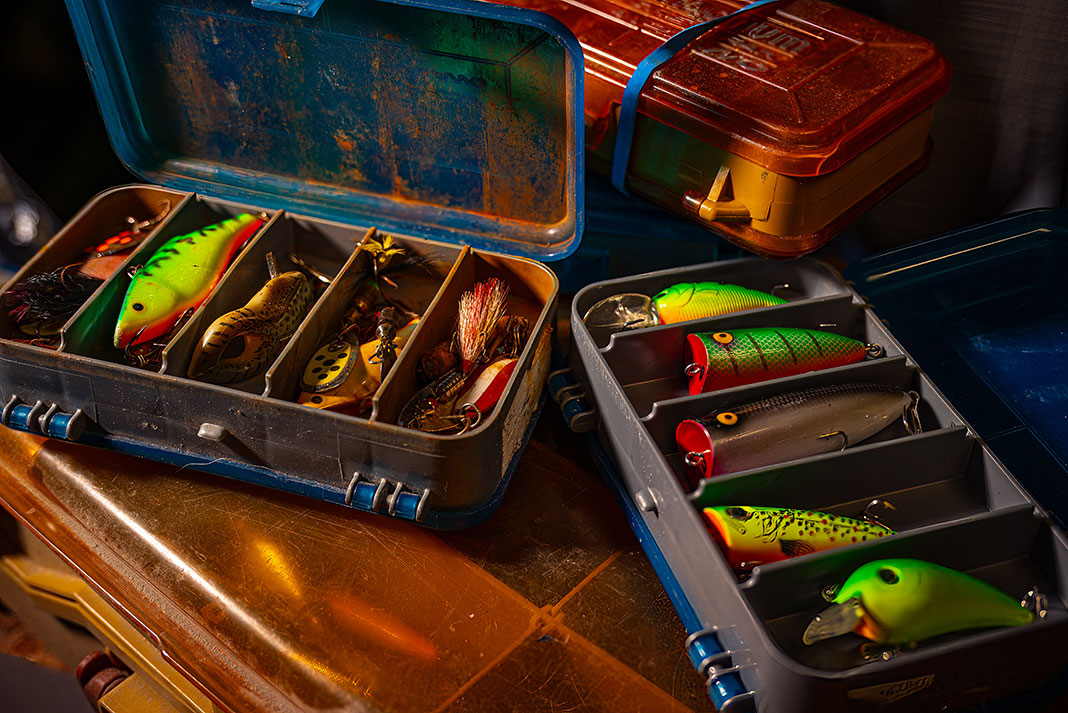You can tell a lot about a kayak angler by looking in his tackle box. Minimalist, maximalist, budget or baller, the evidence is in how he stores his lures, hooks, swivels and sinkers. Each angler approaches storage differently, but kayak anglers require compact, sturdy and versatile tackle boxes.
Four Tips for Choosing the Perfect Tackle Box
The Right Pick
Space is limited and weight capacity is at a premium on a kayak—leave the top-loading tackle box you inherited from your grandfather at home. In an experienced angler’s kayak, you’ll see tackle trays and resealable plastic bags filled with a carefully selected assortment of lures and rigs—this is inarguably the best way to achieve a compact and light storage system.
A tackle tray or utility box is a thin, flat, rectangular box with a clear plastic lid. Inside the tray, dividers hold lures and tackle in place.
Resealable plastic bags, like Ziploc storage bags, hold rigs and bags of soft plastics too large to fit in a tackle tray. These heavy-duty plastic bags with heavy-duty zippers protect rigs from moisture and store a lot of gear in a small space.
Soft-sided tackle bags and modular storage systems are great for storing multiple tackle trays and bags in the truck or garage, but are overkill for your kayak. You’ll have more storage options if you bring just the tackle trays and resealable bags aboard—and only the ones containing the specific tackle you need for the day.
For example: tackle trays and utility boxes come in a wide variety of sizes and configurations, but sizes 3600 and 3700 are the most popular because they easily fit in crates and onboard storage cubbies.
Made Tough
A tackle tray lives a rough life—banging around in a storage crate, sliding around the back of the truck, being exposed to water and dirt, and being filled to capacity with lures and tackle. To live up to expectations, a tackle tray must be durable.
The best tackle tray for kayak fishing is reinforced with sturdy materials and has a strong construction. Look for a box with a sealed lid, thick plastic body, heavy-duty hinges and sturdy latches. Be sure the dividers fit snugly in the tray to keep tackle from shifting and mixing. Selecting a tackle tray with a fade- and scratch-resistant clear lid will ensure you’re always able to see the contents—but you can also label the boxes with a permanent marker to quickly grab the right one.
To prevent corrosion on lures and tackle, technologically advanced tackle trays use special plastic that creates a chemical reaction with metal parts, protecting them from rust. Look for trays from Plano made with their Rustrictor technology and from Flambeau Outdoors infused with Zerust.
Everything In Its Place
One of the biggest challenges in kayak fishing is carrying everything you need without overpacking. Choosing a few essential lures is like picking a favorite child for anglers. With proper organization, you can maximize tackle in a minimal space.
Tackle trays and storage bags make it easy to sort tackle by type. Load each tackle tray with only the lures and rigs you need for each outing.
Inside the tackle tray, removable dividers customize the space for longer lures or tiny terminal tackle. Some tackle trays use dividers designed for specific lures, like spinnerbaits, crankbaits or jigs. The correct divider configuration keeps the lures from damage or tangling.
Organize soft plastics by type or size and keep each rig in a separate resealable bag. Store soft plastics in their original packaging inside the storage bag to quickly note the size, style and color of the soft plastic and protect plastics from mixing and being contaminated.
On-Water Storage
The key to an effective tackle storage system is mobility. On each fishing trip, tackle and gear have to be loaded and unloaded from the kayak. Use a large tote to quickly move gear from the garage to the truck, and from the truck to the kayak.
Most anglers use a gear crate in the rear tankwell to organize tackle in the kayak. Choose a crate that matches the size of the kayak’s tankwell. File the tackle trays inside the crate with the hinge down and the latch facing up to keep the box from inadvertently opening and spilling its contents.
Many fishing kayaks are designed with cubbies and molded inserts to store tackle trays and bags. Keep the most-used lures and rigs close at hand. Use bungees to secure tackle boxes and bags in the crate and cubbies.
Properly storing tackle increases efficiency and reduces the risk of damaging or losing gear. Choosing a few essential lures and rigs isn’t easy, but reducing weight and clutter makes kayak fishing easier and more fun.
Unlock the angler’s arsenal. | Feature photo: Robert Faubert
